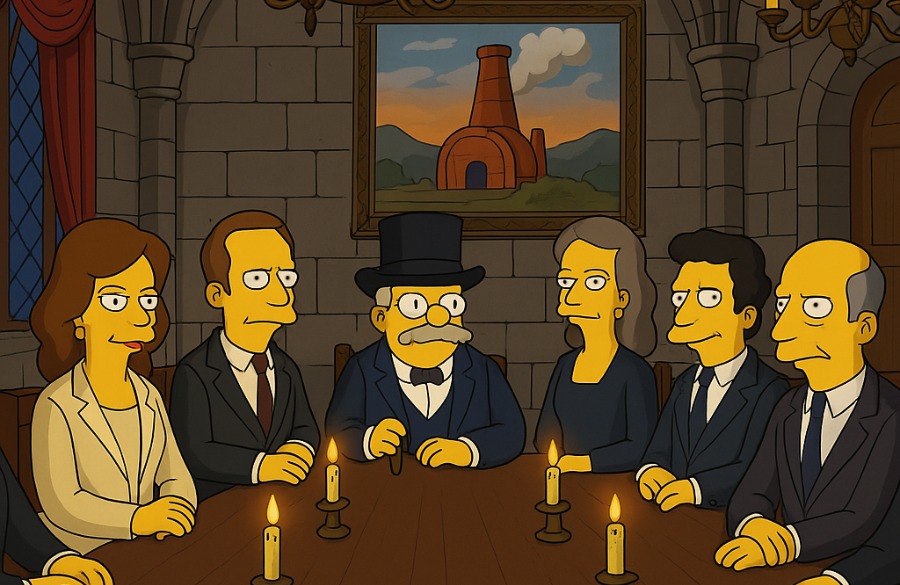The Creature of Lehigh Valley

A rare glimpse of the Creative Minds of Cement in their natural habitat - a castle. (OpenAI)
It was a crisp autumn morning in late 2021 when the tolling of bells echoed through the vaulted halls of Castle Valkenhorst, perched high on a European hillside. Inside the grand chamber, beneath carved wood and flickering chandeliers, the leading cement magnates of the Western world gathered.
At the head of the long table sat Baron Magnus Clinkerton of NordCem, his cane tapping on the oak. Around him: Lady Isobel Stein of LimeRock International, Sir Alvaro Montague of Continental Hardbind, and a half dozen others in dark tailored suits.
Magnus cleared his throat. “Colleagues,” he began, “you’ve seen the numbers. Our domestic operations in the United States are facing an energy shock. The price of natural gas is surging — in June it was around $2.70/MMBtu, by early October it touched near $6.00/MMBtu. (Northwest Power and Conservation Council) We cannot swallow this without response.”
A murmur swept the room. Isobel leaned in. “As you know, we have been championing our blended-cement concept — let’s call it “Type-L” for now — for over a decade. But uptake in the U.S. remained slow. The last green push in the early 2000s fizzled when the economy collapsed. This — this is our moment.”
Alvaro smiled thinly. “And if I may add a bit of… strategic timing. At a dinner last week with Count Sergei Borisov in Geneva, a whisper reached me: that Mr. Putin is preparing an invasion of Ukraine. If that happens—if pipelines are disrupted, LNG remains constrained—you know what that means for global gas markets. We’ll have the perfect excuse to act.”
Silence. Then Magnus raised his glass. “To disruption then.” They clinked.
Isobel stood. “Here is the plan. We dust off Type-L. We reduce the clinker content by replacing a portion with limestone dust. Energy per ton falls. Our plants will consume less fuel, less electricity. Then we raise our selling price — cite as the cost of doing business in post-pandemic, post-conflict America. We announce: ‘Production constraints due to workforce scarcity, COVID-impacts, supply-chain disruption.’ Meanwhile, internal cost-base drops. Brilliant.”
Alvaro nodded. “And we package Type-L as the climate solution. ‘Low-carbon cement.’ Because we use less clinker, we can claim CO₂ reduction — even though anyone who bothered to think knows concrete is already one of the least carbon-intensive major building materials per buildable square foot. But the public doesn’t care for nuance.”
Magnus grinned. “Exactly. We are the benevolent industrialists handing the planet a breakthrough — while safeguarding our margins.”
Lady Isobel paused. “Gentlemen (and ladies), let’s be clear: The energy crisis is real. But our pivot to Type-L makes it our opportunity. Roll-out in U.S. markets begins December/January. We’ll secure the DOT approvals; we’ll plant the narrative. U.S. energy costs spike — we appear to meet the moment.”
The dark suits applauded quietly. Outside the windows, the first snows of winter dusted the battlements.
And so the cement oligarchy—in their castle, behind closed doors—put the plan into motion.
A surge in natural-gas and electricity costs became their launching pad. A geopolitical rumour about Putin’s Ukraine gambit served as the trigger. Type-L (formerly niche) became the headline. Consumers would see “green innovation.” The manufacturers saw margin.
The world forged ahead, but quietly the mix-design shifted. Clinker turned to limestone. The price tag ticked up once more.
And in the hush of Castle Valkenhorst, they raised their glasses again. “To structure,” Magnus whispered, “and opportunity.”
Outside, markets shifted. Natural-gas surged. December crept in. The world moved on — unaware.
A fictional tale brought to you by the minds at Concrete Logic....











